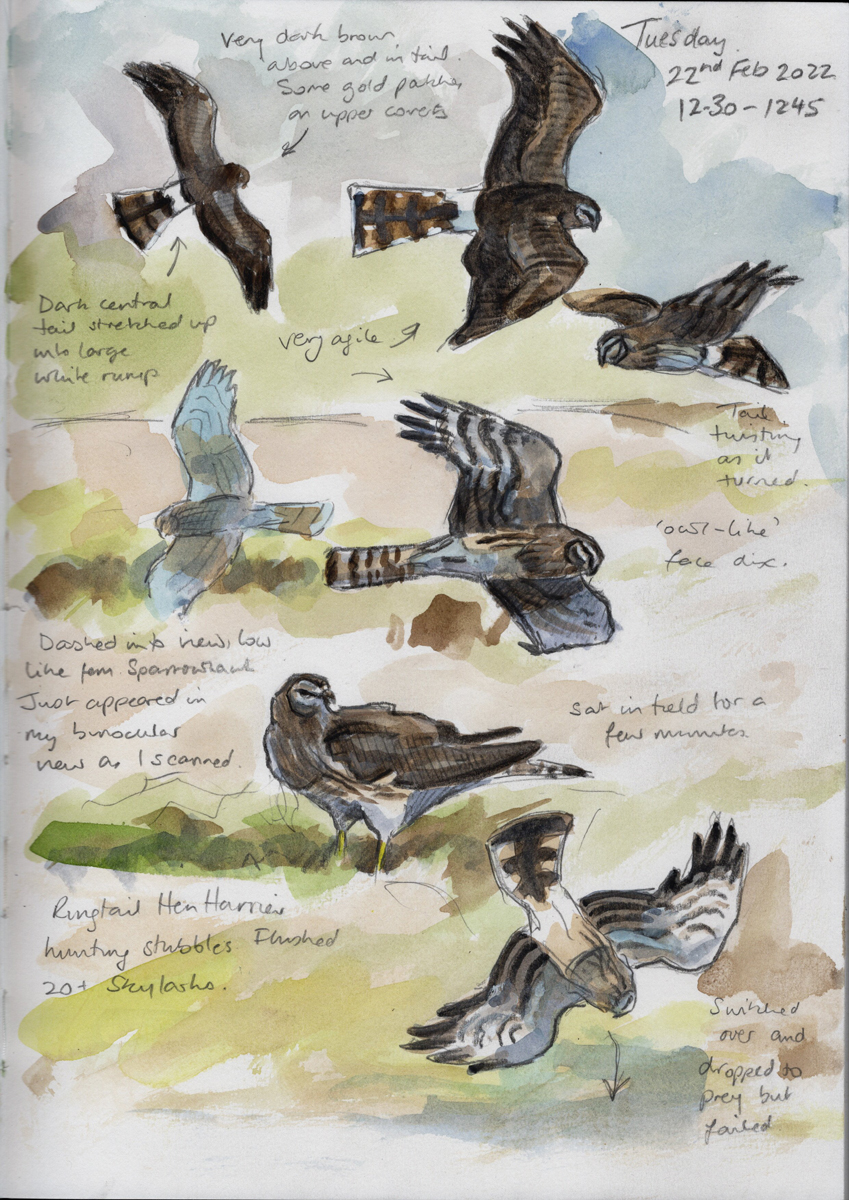My local patch list is kept on a colour coded excel spreadsheet. The species are listed down the left hand column and the years are horizontally along the top. I've described it on here before, so to get the full boredom feel, see link.
This makes it easy to monitor the species, what is missing for a given year etc. The exciting bit (well ok, the exciting bit for me) is to see how many 'red' species turn up in a year. These are species recorded on 3 or less years since recording began in 2009. The birds might not be rare on your patch or on a national or even county level, but on mine they make the heart skip a beat.
On Tuesday one such species turned up for the 2022 list, my first 'reddity' of the year.
At lunchtime I was out taking Peggy for her walk. The coast seemed quite busy with a layby full of cars, so we headed off down the 'Teepee Track'. It is a bridle path that runs south from Seahouses Farm where it passes the now defunct site of a reconstructed neolithic hut. It's a mostly bird barren site apart from a stubble field that holds a few finches and larks and it was while scanning for these, the birding took a turn for the better...
We were stood on the old teepee site as I scanned north west across the field hoping for a twite or lapland bunting or even a Meadow Pipit that has not shown so far this year, when, into my binocular view , dashed a direct, low flying, raptor. The first thought was female Sparrowhawk but it looked odd, darker, when it turned to reveal a massive square white rump - a ringtail Hen Harrier!
On this site, Hen Harrier is a knee trembling rarity with only one previous record from 2010 during that hard winter. Concentrating, I leaned on the fence to get the best possible steady views of the bird, thinking it was just passing through. Luckily for me, it was in hunting mode and began quartering the stubble, hovering, sometimes with legs dangling before changing direction and taking another line. It was flushing larks and linnets all over. The sun was behind me, lighting the harrier beautifully as it floated and pirouetted around the field for about 10 minutes. Once it even landed for a look around before getting back up and quartering its way to the north and off towards our village. I wonder if it went over our garden?
Without a camera, I concentrated as much as possible so I could do this sketch as soon as I got back in to the house...
What a great 'red box' bird for my Local Patch year list...


7 comments:
Fantastic! I think I've seen just four on my old patch at Seaton, but none so far here in West Dorset. So I can totally relate to the wow-ness! 😄
Fabulous stuff! Such beautiful paintings too.
Gav - Cheers, they are a rare bird on the coast up here, hence the shock and awe despite having a nice male only a few weeks ago on the moors...
Seven hens - Thank you...
Brilliant!! I was up your way 2 weeks ago, had lunch in Craster with in-laws, then our birdathon on the Saturday:
http://bangorwestndcp.blogspot.com/2022/02/mid-term-report-from-england.html?m=1
Nice... I keep missing the overwintering one's across the Somerset Levels and along the coast, so good to know you caught up with the ringtail.
Hi Stewart - congrats on your red Hen Harrier! Following your previous spreadsheet post, which I commented on when I read it, I finally got round to turning my Galley patch year list spreadsheets that go back to 2004 into a summary spreadsheet for all years to date. So I can now tell you that Hen Harrier is a (erm) mauve species at Galley, having been seen in 6 out of 19 years. (Not too sure about the colour scheme yet - think it needs further work!)
Anyway, I have a question on this - obviously as time goes by, your patch stats will be based on a longer time period. And you will see (some) rare species again. So do you downgrade those red species when you've seen 4 or more of them? Even though the number of years between sightings could be the same? i.e. 3 sightings in 15 years might become 4 sightings in 20 years - the rate of sightings is the same. I'm not sure how to approach this for my spreadsheet, but wondered if you'd thought about it? Or perhaps you're not sad enough?
Cheers,
Col
Hi Col, Thanks for the comment. Oh yes I am sad enough, for sure, and yes it does cross my mind quite regularly. I think the definition of 'rare and scarce' will need to change as time wears on. So far, 13 years on, I am still ok with my status boundaries. For example any BB rarities will always be red birds. The problems lie with locally rare species such as, for me, Black tailed Godwit, Storm Petrel or White fronted Goose. Some of these birds might under go a status change. We can possible set a time boundary say, one year in every 5 years or 10 years or whatever ? I'll have a think on it. Feel free to email me at stewchat(a)btinternet.com and I'll get back to you....
Im pleased my spreadsheet inspired someone! :)
Post a Comment